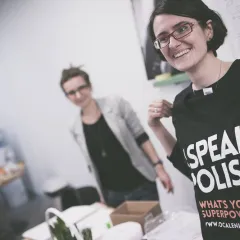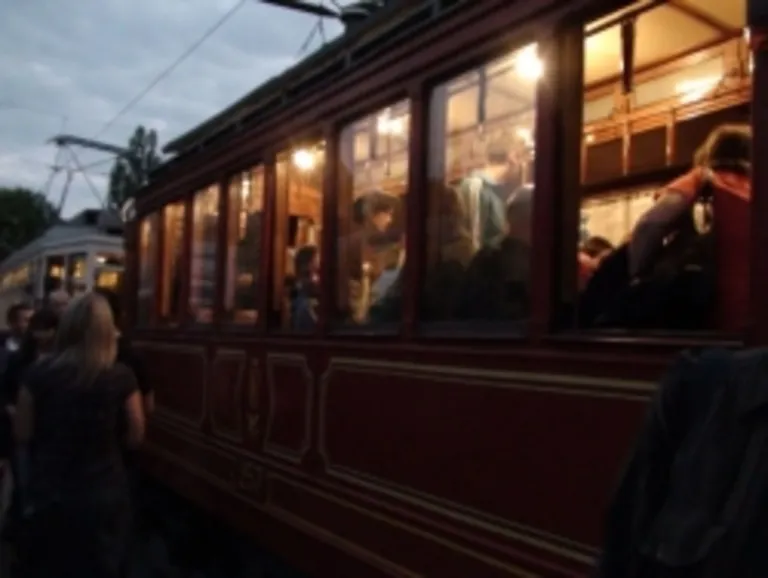More and more modern trams run on rails in Warsaw. Elegant, quiet, low-floor cars. So pleasant to look at. Recently I’ve seen off one of my Senegalese compatriots. We were waiting at the tram stop near Plac Narutowicza. The chap didn’t want to get on just any tram. ‘You’re kidding me. Am I supposed to go by an old tram? Now we have cool ones, they’re as comfy as planes. I’m not going by this wreck.’ The tram drove off. We waited a couple of minutes. And then a yellow-red technical miracle arrived. Indeed, a streamline shape, air conditioning, comfortable seats, led displays showing the name of the stop, a voice announcing the next stops... More and more modern trams run on rails in Warsaw. Elegant, quiet, low-floor cars. So pleasant to look at. Recently I’ve seen off one of my Senegalese compatriots. We were waiting at the tram stop near Plac Narutowicza. The chap didn’t want to get on just any tram. ‘You’re kidding me. Am I supposed to go by an old tram? Now we have cool ones, they’re as comfy as planes. I’m not going by this wreck.’ The tram drove off. We waited a couple of minutes. And then a yellow-red technical miracle arrived. Indeed, a streamline shape, air conditioning, comfortable seats, led displays showing the name of the stop, a voice announcing the next stops...
There's only one 'but'. Having all information available inside the vehicle isn’t conducive to conversation. Or maybe not conversation itself but ‘establishing relations’. We get no chance to chat up some attractive passenger and ask: ‘Excuse me, where’s X Street or Office Y? Is it this stop or the next one?’
For someone who doesn’t know (or he pretends so) if he should get off at this stop or the next one, means of public transport might be a good place to get to the know the opposite sex. Not only in purely informative purposes. Certainly, a conversation started in such a way may end up with getting an answer. It might also be a begging of a longer conversation, acquaintance or even a relationship. Electronic information system and voice announcement system are undoubtedly a great solution but they don’t help a spontaneous “integration” and getting to know other passengers.
I don’t have a car although I passed a driving test quite a long time ago. Therefore, I got used to public transport. Bus lanes are getting better. Trasa Łazienkowska, aleja Solidarności from Dworzec Wileński towards the Old Town set a good example. You can quickly go to certain places by bus. Most usually, however, we stuck in traffic jams because of lack of special lanes.
One of my friends, a guitarist from Mauretania and SGH graduate (Warsaw School of Economics) who’s currently living in Norway, once told me that in Scandinavia even at midnight, when the devil is asleep, all the more the police, no driver would use a bus lane. What a discipline! Or maybe fines are so high? Such regulations would be definitely helpful in our country on the Vistula River.
Why am I writing about trams? Well, since my daughter was born and we had to buy a pram, my perspective has dramatically changed. I’ve never been interested in the pavements condition. When I came across a hole I simply went around it and that was it. Admittedly, cars are sometimes parked without leaving the regular space of 1.5 m to let the pedestrians freely pass by on the pavement. At that time, I didn’t care for the type of door (single or double) in trams, their width or if there was a middle handrail or if the door were adjusted to carrying in the prams.
The problem is that old cars are equipped with special handrails attached to doors, which dramatically narrows the entrance. The difficulties appear when I want to get on by myself while carrying the pram. This how I do it. When the door is wide enough I don’t need anyone’s help.
The old trams don’t allow for that. The handrails make it impossible to get inside with a pram.
I’ve learnt to recognize the types!!! I love the new ones not only for their aesthetics but also comfort and accessibility for the elderly and the disabled. In the perspective of a pram two things are taken into account: low floor (height reduction between the stop and the tram’s entrance) and the door’s width. Long live the low-floor trams!
What about the types of trams? Just to mention a few: 123N, 105N, 105N2k, 13N, 120N.
105N is old but it’s easy to get inside with a pram. It’s one of my favourites even though the doorstep is quite high as it consists of three steps. However, the middle door is wide. You can easily get on with a pram all by yourself. There’s a sticker with a drawing of a pram on the right door. The same advantages characterize 105N2k and 123N and they are newer than the previous one.
The newest purchase is the one mentioned by my compatriot: 120N. Low-floor and quiet as a plane. Cool. More of them run on rails. Opposite to the second door there is a place for a wheelchair or a pram. You can get on and off without the slightest problem. Additionally, extended under-floor ramps are installed near the door. Pure joy! Moreover, the tram is quiet and it doesn’t moan. What more could you want?
Please don’t ask about the worst. Such a tram just pulls in and spoils your mood. It’s called Konstal 13N. What is it, actually? This technical relic (some call it a living corpse) has high steps (but it’s not an exception). There’s a sticker of a pram on the middle door but it’s impossible to come inside because of a handrail. I miss out on 13N and wait for other models (not only on Fridays). Some time ago I didn’t consider the types of trams. I wanted to get somewhere, so I got on when the line was right. With a child I have a different view of the pavements, the width of the bus door or tram door, the height of steps (there are no lifts near Dworzec Centralny or along Trasa Łazienkowska). Now I start to notice how man is treated by the architecture and planning.
I read that new trams will be delivered to Warsaw in stages. By the end of this year we’ll gain 33 and before EURO 2012 there will be 120 of them in Warsaw. All new trams are low-floor, air-conditioned, equipped with ticket machines and monitoring, have wide entrance and a place for a pram with a nice, soft backrest for a person with a child.
What I like most is the voice announcement of one of the stops in Ochota. I mean the crossroads of two streets: Banacha and Górecka. Passing the old cinema Ochota (nowadays Och Teatr) I hear “the next stop ‘Bitwy Warszawskiej 1920 roku’ (Battle of Warsaw). It really sounds impressive. In every model.
Mamadou
Tłumaczenie: Iwona Białek

















